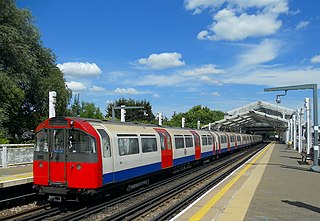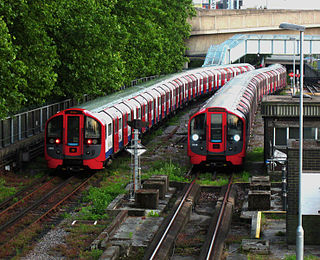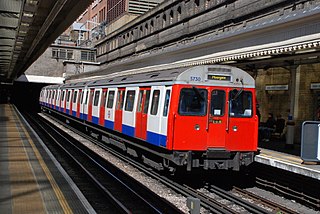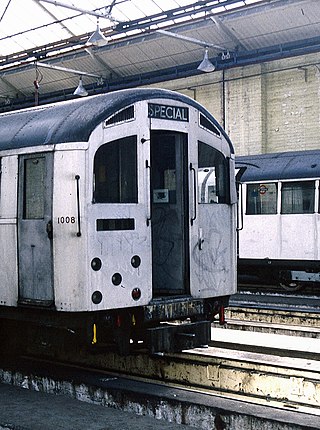
The London Underground 1973 Stock is a type of rolling stock used on the Piccadilly line of the London Underground. It was introduced into service in 1975 with the extension of the line to Hatton Cross, followed by a further extension to Heathrow Central in 1977. A total of 86 six-car trains were built.

The 1959 Tube Stock was a type of London Underground tube train constructed in the late 1950s. They were intended for use on the Piccadilly line, but also saw use on several other tube lines. It was the first production tube stock to have unpainted aluminium alloy bodywork.

London Underground rolling stock includes the electric multiple-unit trains used on the London Underground. These come in two sizes, smaller deep-level tube trains and larger sub-surface trains of a similar size to those on British main lines, both running on standard gauge tracks. New trains are designed for the maximum number of standing passengers and for speed of access to the cars.

The London Underground 1938 Stock was a London Underground tube stock design. A total of 1,121 cars were built by Metro-Cammell and Birmingham RC&W. An additional 173 cars were added to the fleet by the end of 1953, comprising 91 new builds, 76 conversions from Pre-1938 Tube Stock or 1935 Tube Stock, and six unconverted cars of 1935 Tube Stock, and the stock was used on the London Underground until 1988. During their long lives they worked on the Bakerloo, Northern, Piccadilly, East London, Central, and Northern City lines. Ten sets were refurbished and ran on the Isle of Wight as Class 483, making them the oldest passenger rolling stock operating timetabled services on the National Rail network at the time of their withdrawal in January 2021. The trains represented a major technical advance, as all the electrical equipment was located under the floor for the first time. All previous tube stock had large equipment compartments behind the driving cabs in motor cars, which reduced the space available for passengers by about a third.

The Standard Stock title was applied to a variety of Tube stock built between 1923 and 1934, all of which shared the same basic characteristics, but with some detailed differences. This design is sometimes referred to as 1923 Tube Stock, 1923 Stock, or Pre 1938 Stock. Most of the Standard Stock was built to replace the first generation of "Gate Stock" Tube trains or to provide additional trains for extensions built in the 1920s and early 1930s. Standard Stock cars consisted of motor cars, with a driver's cab, behind which was a "switch compartment" occupying approximately one-third of the length of the car, plus trailer cars and "control trailers", with a driving cab but no motor. All were equipped with air operated sliding doors. The guard's door on the earlier trains was a manually operated, inward-opening hinged door.

The Q Stock consisted of various District line trains, built from 1923 until the mid-1930s, originally built with manually operated sliding doors. Following conversion to air operated doors, the trains became collectively known as Q Stock. Given that five different types of rolling stock were converted to Q Stock, the resulting hybrid trains looked bizarre - with the older carriages having flat sides and clerestory roofs, whilst the Q38 had flared sides at floor level.

The London Underground O and P Stock electric multiple units were used on the London Underground from 1937 to 1981. O Stock trains were built for the Hammersmith & City line, using metadyne control equipment with regenerative braking, but the trains were made up entirely of motor cars and this caused technical problems with the traction supply so trailer cars were added. P Stock cars were built to run together with the O Stock cars now surplus on Metropolitan line Uxbridge services. The trains had air-operated sliding doors under control of the guard; the O Stock with controls in the cab whereas the P Stock controls in the trailing end of the motor cars. The P Stock was introduced with first class accommodation, but this was withdrawn in 1940.

The London Underground 1962 Stock was a type of London Underground tube train built for use on the Central line. They were used on the Central line between 1962 and 1995, with some later being transferred to the Northern line where they were used until 1999.

The London Underground 1960 Stock was a class of electric multiple unit for the London Underground Central line. Twelve motor cars were supplied by Cravens, and pairs were made up to four cars by the addition of two converted standard stock trailers. A production run of 338 motor cars was shelved, due to the time needed to assess the new features and the cost of converting the trailer cars. Some of the pre-1938 trailers were later replaced by 1938 stock trailers.

The London Underground C69 and C77 Stock, commonly referred to as the C Stock, was a type of sub-surface rolling stock used on the Circle, District and Hammersmith & City lines of the London Underground between 1970 and 2014. They were replaced by the S7 Stock.

The London Underground 1967 Stock was a type of deep-level train that operated on the Victoria line of the London Underground from the line's opening on 1 September 1968 until 30 June 2011. It was also used on the Central line between Woodford and Hainault between 21 February 1968 and 1984, as the same automatic train operation (ATO) system was used on both lines.

The London Underground 1996 Stock is a type of rolling stock used on the Jubilee line of the London Underground. The trains were built by GEC Alsthom-Metro-Cammell and entered service in 1997. They are similar to the 1995 Stock used on the Northern line.
Rolling stock used on the London Underground and its constituent companies has been classified using a number of schemes. This page explains the principal systems for the rolling stock of the Central London Railway (CLR), the Underground Electric Railways Company of London (UERL), the District Railway (DR) and the Metropolitan Railway (MR). For information about individual classes of locomotives and other rolling stock, see London Underground rolling stock.

The London Underground 1956 Stock consisted of three prototype units built before mass production of the 1959 tube stock. These units were tested on the Piccadilly line and remained in service after production trains were introduced. Later they were transferred to the Northern line, but in 1995 they were replaced as non-standard by 1962 Stock cascaded from the Central line.

The London Underground Q Stock were trains used on the District line of the London Underground. First introduced in 1938, these electric multiple units were formed from cars built between 1923 and 1935 and new purpose-built cars, and fitted with electro-pneumatic brakes and guard controlled air-operated doors. Trains were made up from cars of different ages with differing appearances, the older ones with clerestory roofs and the newer ones with flared sides. Some units were withdrawn in the early 1960s, although six- and eight-car trains remained on the District line with use gradually diminishing to peak hours only, and four car units worked the East London line until 1971.

Metropolitan Railway electric multiple units were used on London's Metropolitan Railway after the lines were electrified in the early 20th century.

District Railway electric multiple units were used on London's Metropolitan District Railway after the lines were electrified in the early 20th century.

Departmental locomotives on the London Underground consist of vehicles of a number of types which are used for engineering purposes. These include battery locomotives, diesel locomotives, electric locomotives, sleet locomotives, pilot motor cars and ballast motor cars. Details of the first four types are covered elsewhere. Pilot motor cars and ballast motor cars are generally vehicles which have been withdrawn from passenger service, but continue to be used by the engineering department. Pilot motor cars are used to move other vehicles around the system, while ballast motor cars are used to haul ballast trains and engineering trains.

Acton Works is a London Underground maintenance facility in West London, England. It is accessed from the District line and Piccadilly line tracks to the east of Acton Town station, and was opened in 1922. It was responsible for the overhaul of rolling stock, and gradually took on this role for more lines, until the formation of the London Passenger Transport Board in 1933, when all major overhauls of underground vehicles were carried out at the works. By 1985, when rolling stock had become more reliable and maintenance intervals had increased, this function was devolved to depots on each line. Subsequently, Acton continued to overhaul major items after they had been removed from trains at the depots, and tendered for work, which included the conversion of the A60 Stock to One Person Operation. It is likely to be reorganised and expanded to house the departments displaced from Lillie Bridge Depot which is being demolished as part of the redevelopment of Earls Court Exhibition Centre.

Morden Depot is a British rolling stock depot on the London Underground Northern line, and is located to the south of Morden Underground station. It was opened in 1926, when the City and South London Railway (C&SLR) was extended from Clapham Common to Morden.





















